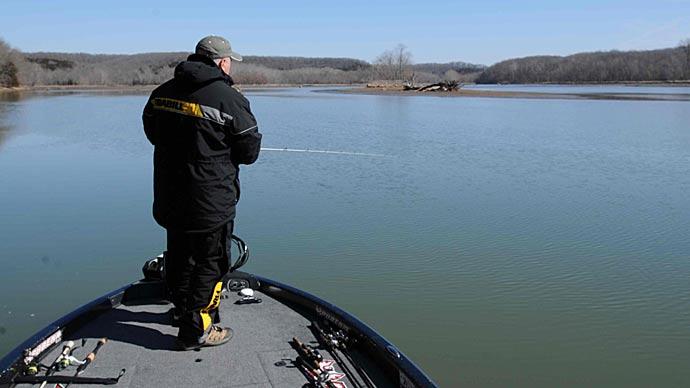
Over the past several months, two major Western tournaments have been won using a new, yet not-so-new method -- dropshotting. This technique was developed in Japan quite a few years ago. I know many people here in the United States are taking credit for it, but dropshotting has been a hit for a long while in Japan.
In Japan, bass tournaments may draw from 600 to 800 boats, and because the lakes they typically fish in are relatively small, you can't begin to imagine the fishing pressure they experience. Dropshotting has been the number-one technique for catching fish and winning tournaments in Japan for the last five years, despite the pressure.
The Japanese name for dropshotting, which I won't attempt to pronounce, means "always lucky.' Through my contacts with "Lucky Craft," I've gotten to know many people in Japan and have learned quite a bit about this 'always lucky' technique: how they fish it, why, when, and where. The two tournaments I mentioned earlier were won from 30 to 60 feet of water. Mostly, folks here believe dropshotting is just for deep water. That's not entirely true.
Dropshotting is a rig with a weight on the bottom of the line, and the hook is tied directly to the line from a few inches to a couple of feet up from the weight.
When the water starts to warm in the spring, the bass move up in the sunlight zone to warm their bodies; they absorb the ultraviolet rays. They will often be within a foot or two of the surface. So you might be flippin' in 5 feet of water, but the fish are sitting in 2 feet. Using the 'dropshot rig,' your lizard or worm is also sitting at two feet.
Shallow-water dropshotting is a method I learned in Texas. We would throw lizards in the tops of trees and let them settle down through two or three feet, and the fish would suck them right down. Then, we shook the bait right in their faces, and suddenly, they would swim off with it.
The shallow dropshot rig calls for 3/8-ounce to 1/2-ounce weights, depending on the depth you're trying to fish and the size of your bait. I have had success using 4-inch lizards. There are no secret colors. The normal ones are fine. You must get tuned in to the bait and learn how to work it. I believe it's the most deadly method today.
I've noticed that even in tournaments, you can catch 25 or 30 fish, but if the guy in the back of the boat doesn't have the proper rig, or if he isn't tuned in, he won't get a bite the whole day. Success with dropshotting is mostly line control and presentation.
Most of the time, even when I'm dropshotting in the deeper water, I never cast; it's more of 15- to 20-foot pitch. I want to get the bait down to the bottom and get an excellent direct line to it. I know that people think when you dropshot, you fish vertically. Sometimes that's true, but I usually like a slight angle to my line.
When fishing with these techniques, it becomes essential to use your finder; you must be superb with it. Earlier this year, while at Lake Pleasant, I had borrowed a boat because I'd sold mine, and it took me a whole day to learn my depth finders.
The pattern on Lake Pleasant then was to find a tree with fish in it, drop your bait right in the tree, and catch the fish every time. But, the key was to drop the bait where the tree was. The bass ignored the bait if you missed the tree by 10 feet. So, you had to get right into the tree with him.
There was one spot on Lake Pleasant where I saw a fish in a tree down 50 feet. Learning how to turn your boat, run your meter, and still get that bait right in the tree with the fish takes practice. You might spend 10 to 15 minutes trying to properly present the bait to a big fish in a tree. If you work at it, though, you can do it.
Remember I said earlier that a guy could catch much fish, and his partner might not get a single bite? The difference, most of the time, is control. I have yet to be slammed on a dropshot rig. I'll drop the bait down and keep the sinker in touch with the bottom; then I shake the bait, not enough to raise the weight off the bottom, but I shake it nonetheless. My rod tip might move an inch or two, but no more. The bait moves slightly just by popping the slack out of the line. Even at 60 feet, you will notice that. I know the bait is moving, but more importantly, I'm keeping pressure on the line, staying in touch with my bait.
By not lifting the sinker off the bottom, I'm maintaining pressure. When the pressure changes, I set the hook. Of the 30 fish a day I've caught, I have only felt maybe five or six of them before I set the hook. All I noticed was a pressure difference.
The dropshotting bite is not an old jig bite or anything like that. It is a subtle, finesse technique. It's like doodling with patience. Once the cast is made and your weight has reached the bottom, you simply drift along and shake, shake, shake that bait. If, after a while, you don't get a hit, then you repeat the process, maybe 10 feet to the left. Each cast could take up to 5 minutes to complete. Did you get that? I said each cast might take up to 5 minutes! Remember, you are drifting along with the wind or currents. You don't stay in the same spot all the time. Dropshotting is rigged with a swivel weight at the bottom of the line, and the hook is up from the weight between 6 and 20 inches, depending on where the fish are holding.
In the tournament on Lake Pleasant, more fish were caught on an 18- to 20-inch separation between the weight and hook than the shorter rigs. I'm sure that length of rigging is a crucial part of dropshotting success. Experiment, and always have two rigs -- one shorter and the other longer.
The knot the Japanese use on their dropshot rigs is a Palomar. You tie the knot, leave an extra long tag end coming out of the knot, and then take that tag end, and while holding the hook with the bend pointing up, you thread the tag end back down through the eye of the hook. The result is a hook always pointing up because the weight tied on the bottom of that tag end puts pressure on the hook and keeps it in the proper position. This is extremely important because this aspect will increase your hook-setting percentage by a considerable margin.
There are two different ways I fish the bait while dropshotting. A weedless 1/0 Owner worm hook -- Texas-rigged -- seems to work well. I also fish an open hook system. I use a smaller #2 hook and attach the bait through the nose. So it's essential to have that #2 hook pointed up where it will hook them in the mouth or lip as it comes out of their mouth. For deep applications, I prefer a 1/4-ounce bottom weight.
The line size used for dropshotting -- for the most part -- is light, light, light. I almost exclusively use 6-pound-test line. I use Tatsu Fluorocarbon line made by Seaguar.
I use fluorocarbon line in deep water because, being very dense, it sinks fast. So, when you pitch the rig out, and it goes to the bottom, you have a much more direct feel to the bait. Fluorocarbon lines don't have as much bow to them as other lines, translating to a better feel. You see, most lines fight going down; they try to get back to the surface. That's why lines bow. When your line bows, you've lost a lot of the feeling necessary to dropshotting.
I'll only use heavier lines when I flip those shallow-water fish. Then I'll go to 15- to 20-pound line. Otherwise, you can't beat the feel, down deep, of 6-pound test.
Another important aspect of using a light line is often retying your knots. Because of the way the hook is tied to the line, each fish you catch will run its teeth across the line, weakening it. Even the best lines aren't entirely abrasion-proof. I don't know a shortcut here. I'll say tie and retie often.
Dropshotting is undoubtedly the wave of the future. It does too many things right. It gets the bait to the fish and is subtle enough to entice a bite without spooking the bass. It has many applications, and as this year progresses, I predict many tournaments will be won using these techniques.
It would be great to think I invented dropshotting, but the truth is, the Japanese have been using their 'always lucky' method for many years. I'm just glad my friends shared it with me. I hope it helps you catch more fish.
Reprinted with permission from Bass West Magazine





